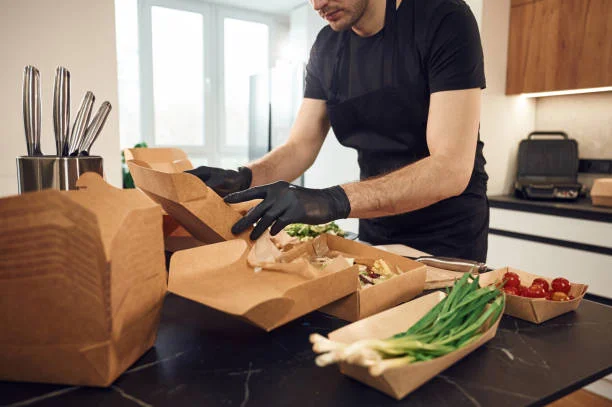Nowadays, the first impression of a restaurant is formed not in the dining room, but in the hands of the customer at home or in the office. Premium disposable packaging becomes an extension of the restaurant’s philosophy and a powerful marketing tool. The choice of packaging can significantly increase customer loyalty and the number of repeat orders.
The psychology of packaging: why details matter
Modern consumers decide whether to reorder within minutes of receiving their meal. Premium disposable food containers create the “unboxing” effect — that excitement of unpacking that turns an ordinary meal into an event.
High-quality packaging influences customers’ perception of the establishment. It is not just a container — it is a brand carrier that continues to work even after the food has been eaten.
High-quality solutions: an investment in the long term
The transition to premium packaging requires an understanding of the technical characteristics of modern materials and their impact on the user experience.
New generation materials
Modern disposable plastic containers are radically different from their cheap counterparts. Innovative composite materials offer excellent functionality and a visually appealing appearance.
The main advantages of such containers are:
- High heat resistance without deformation;
- Reliable sealing, preventing sauce leakage;
- Transparency to demonstrate product quality;
- Opportunities for effective branding.
These characteristics make the packaging not only functional but also marketing-oriented, capable of influencing customers’ perception of the brand.
Ergonomics as a competitive advantage
Well-designed packaging should be intuitive. Customers should not have to break their nails opening containers or guess which sauce is in which container. Professional restaurant supplies are designed with the user experience in mind at every stage.
Beverages as a driver of loyalty
The disposable drinkware segment deserves special attention. A glass with a logo accompanies the customer for the longest, on the road, in the office, and at home. It serves as mobile advertising that works for hours after purchase.
Double-walled cups not only maintain the temperature of the drink but also create a tactile sensation of quality. A matte finish, embossed texture, and well-designed lid ergonomics are memorable details.
Packaging implementation strategies
A successful transition to expensive packaging is impossible without a well-thought-out strategy that takes into account financial capabilities and business characteristics.
A phased approach
A sudden transition to expensive packaging can hurt profitability. A sensible implementation strategy involves gradual changes.
It is worth starting with the most popular items on the menu, then moving on to working with regular customers and high-value clients, and finally introducing premium packaging for corporate orders and holiday menus. This approach allows you to evaluate effectiveness without serious financial risks.
Calculating effectiveness
Increasing the cost of packaging pays off through several mechanisms. High-quality packaging contributes to increased repeat orders, higher average checks, fewer negative reviews, and organic audience growth through customer recommendations.
Branding through packaging: the art of execution
Packaging becomes a powerful tool for communicating with customers when every element works to build brand recognition and loyalty.
Visual identity
Packaging should convey brand values without words. Minimalist design for luxury establishments, bright colors for family-friendly concepts, artisanal aesthetics for signature projects. Every element — from the color of the lid to the font on the sticker — works to build brand recognition.
Functional design
Beauty without functionality leads to customer disappointment. Containers must combine aesthetics with practicality.
Ideal packaging is easy to stack for convenient delivery, can be opened with one hand, retains its presentable appearance after transport, and is suitable for reheating in the microwave. These requirements seem obvious, but many establishments ignore them.
Practical aspects of supplier selection
A packaging partner has just as much impact on a restaurant’s operational stability as a supplier of basic products.
Criteria for selecting reliable partners
Choosing a packaging supplier requires a comprehensive approach. Supply stability is critical for the restaurant business — any interruptions directly affect service quality.
Key factors when choosing a supplier:
- Product certification and compliance with sanitary standards;
- Brand customization options;
- Flexibility in order volumes;
- Speed of response to changing needs;
- Provision of samples for testing.
A reliable partner should not only supply quality products but also advise on optimizing packaging solutions.
Logistics solutions
Modern suppliers of premium packaging offer comprehensive logistics solutions. Warehouse programs allow you to maintain optimal inventory levels without tying up working capital, and automated ordering systems eliminate the human factor in supply planning.
Before you go, this next article might answer your next question.
Seasonal strategies and special offers
The restaurant business calendar is full of opportunities to create special experiences through themed packaging.
Adapting to the event calendar
A restaurateur’s calendar is packed with events, each of which opens up opportunities for special packaging. New Year’s holidays, Valentine’s Day, corporate catering season — these are moments when special packaging becomes part of the festive mood.
Themed packaging does not require radical changes in production processes. It is enough to add seasonal stickers, change the color scheme, or use special inserts with greetings. These details are remembered by customers and associated with the establishment’s care, forming positive emotional connections with the brand.
Measuring results and optimization
Investments in packaging require constant monitoring of effectiveness to adjust strategy and maximize returns.
Key metrics
Packaging effectiveness requires systematic measurement. Competent analytics help to understand the real return on investment in packaging solutions.
Key indicators to track:
- Percentage of repeat orders (retention rate);
- Willingness of customers to recommend the establishment (NPS);
- Frequency of orders from regular customers;
- Impact on the average check.
Without accurate data, it is impossible to assess the real return on investment. Many restaurateurs intuitively feel positive changes, but the numbers provide an objective picture for making strategic decisions.
A/B testing
Implement changes gradually, comparing the results of control groups. Test different types of packaging for different menu segments and analyze customer feedback. Document each experiment — only a systematic approach provides reliable results for strategic decision-making.
Conclusion
High-quality disposable packaging is not an expense, but an investment in long-term customer relationships. In a world where competition is growing every day, details become a decisive factor in choosing.
Professional packaging acts as a silent salesperson, representing your brand in every home, office, and picnic. It creates an emotional connection with the customer and turns an ordinary purchase into an experience they want to repeat.
Packaging is a long-term strategy for building customer relationships that pays off through loyalty and recommendations.
Catch up on the latest updates anytime from 2A Magazine.







